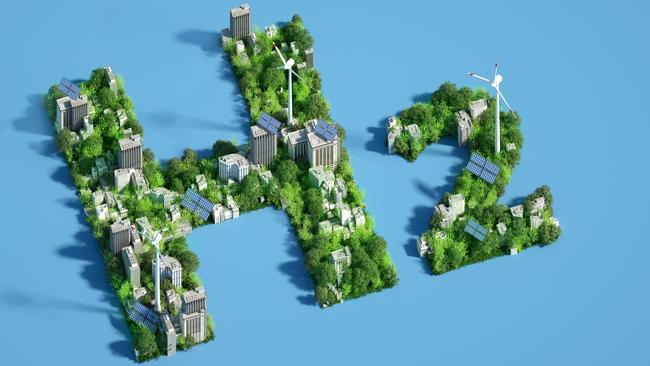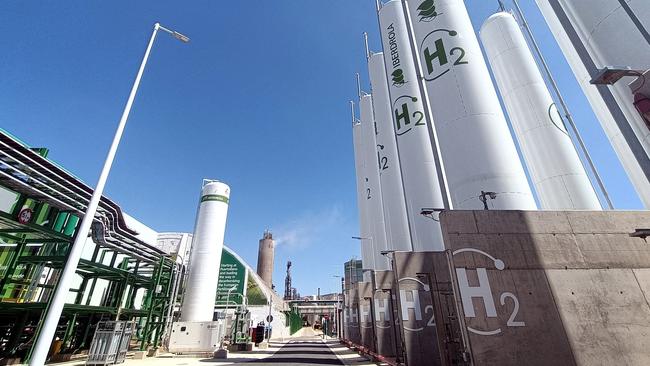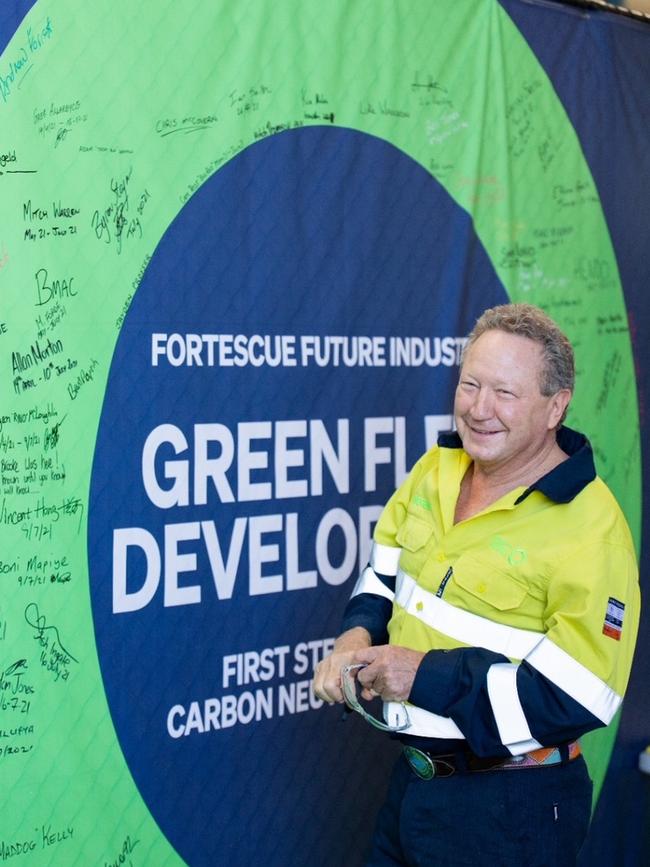Green hydrogen hype fast runs out of steam
The glow of the superfuel is fading and this demands a rethink of its role in the Albanese government’s path to net zero.

Business
Don't miss out on the headlines from Business. Followed categories will be added to My News.
What promised to be a green gold rush is fast turning into a bust, as the limits of technology and costs start, catching up with delivering hydrogen.
From Fortescue’s Andrew Forrest to some of the world’s biggest energy companies, hydrogen has been promoted as the superfuel that can put the world on a fast track to decarbonisation.
However, the cracking technology – which is not new – and then making it commercially viable is proving as tricky as ever.

Now one of Australia’s biggest energy players, Origin, is the latest to curb its ambitions. It’s walking away from its Hunter Valley Hydrogen Hub venture in a major blow to the confidence in the industry as it tries to get off the ground.
And this was no ordinary project. The Origin scheme with partner Orica was one of the most prospective hydrogen schemes in the country.
The decision marks the ongoing evolution of green policy across corporate Australia, with ambition giving way to a new pragmatism.
You kind of have to believe a lot of things to be true, or a lot of things to go your way over a long period of time. You know, we’re talking about a long, dated asset, and, you know, I think with any investment right, there’s always judgment, and you’re constantly to accept some risk and sometimes no reward. But on this project, there’s kind of risk at every single level, and a lot of uncertainty, and that just it all accumulates to a risk profile that we just can’t accept
In making the decision, Origin boss Frank Calabria cited risks around development of technology and input costs (namely energy) as being too high to move ahead. Green hydrogen is a clean gas which is made by splitting it from water using an electrolyser powered by electricity generated from renewable sources. However, it is hugely energy intensive and the costs of producing it are ever increasing.
“The combination of these factors mean we are unable to see a current pathway to take a final investment decision on the project,” Calabria says.
From Origin’s vantage, a lot of things had to go right over a long period of time. However there were too many uncertainties at every level for the potentially hundreds of millions needed to invest.

It comes just months after billionaire Andrew Forrest was forced to downgrade his green hydrogen ambitions; even he was finding the economics too challenging.
Forrest told The Australian at the time that he was still backing hydrogen as a technology, but it was a longer-term play. He would pivot to building out renewable energy generation to drive the cost down and focus on “green” steel.
That move coincided with hundreds of job cuts across his green energy arm, Fortescue Energy as well as his flagship mining business, although Forrest said the cost cutting was unrelated.
One big potential customer for green hydrogen, BlueScope Steel, has long been a sceptic – not so much on the potential but around the timely delivery of green hydrogen.
It has put the technology in the “over the horizon” basket, with the expectation that it won’t be commercially ready until the 2040s. Instead, BlueScope has been looking at other options to cut carbon emissions in steelmaking. Its biggest bet is around direct reduced iron, which is essentially the process of making iron pellets or lumps using natural gas. BlueScope is working with BHP and Rio Tinto on this technology.
Origin’s Hunter Valley site was a trophy project in Australia’s hydrogen quest. The ambition was to produce green hydrogen which was then to be used as a feedstock for the project’s partner, the chemicals major Orica, to replace gas and produce low-carbon ammonia and ammonium nitrate from its Kooragang Island facility.

This would then be used to produce a number of products, including fertiliser and explosives for mining. Over time it was hoped the plant could produce enough “green” hydrogen to displace diesel and therefore also cut emissions. Having Orica aboard as a foundation customer was significant, given ultimate customer demand for most hydrogen projects have been laced in promises rather cold hard contracts.
Orica boss Sanjeev Gan says he was disappointed by the Origin decision, but committed to exploring options for the sector.
The project was one of six that had been short-listed under the Albanese government’s $4bn Hydrogen Headstart kick-starter program and widely seen as the most advanced project under way.
And while it hasn’t received any funding yet, it raises questions about trying to get the numbers to stack up, even with generous government subsidies on offer.
Other projects short-listed for funding include BP’s Kwinana hydrogen project, South Korean energy major Kepco in a project slated for Newcastle, a Japan and Singapore-backed hydrogen export project based in Gladstone and a Texas-backed clean fuels project in Burnie, Tasmania. All are at various stages of feasibility planning.
This week, the International Energy Agency released its latest update on progress on global hydrogen development. And although the number of projects that have reached final investment decisions have doubled, developments are finding it tough to move to the next step, given surging costs mostly around developing electrolysers.
The IEA found a number of big projects are facing delays and cancellations, mostly given unclear demand signals from prospective customers, financing hurdles and operational challenges.
Significantly, China represents the biggest markets for projects moving to the final investment decision stage.
For Origin, there were too many risks in backing green hydrogen at too many turns. Instead, it will shift its focus on a laundry list of renewable energy projects in front of it from wind energy to battery storage – all with an urgent need to be delivered as coal starts to be switched off. Importantly each of these have risk profile that’s far more contained.
johnstone@theaustralian.com.au
Originally published as Green hydrogen hype fast runs out of steam



